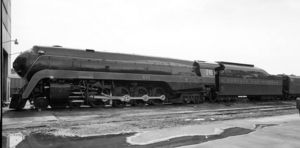Norfolk and Western 4-8-4 J Class

The J class locomotives were streamlined 4-8-4 engines built for the Norfolk and Western Railroad. The first batch were numbered 600-604 and were built in 1941-42. The second batch (605-610) were built in 1943. These locomotives were classed and delivered unstreamlined due to the need of materials during the war. However, they were refitted as Js in 1944. The third batch (611-613) were built in 1950, all streamlined. They were used mainly for express passenger trains. Number 611 is the only surviving member of the class, and was donated to the Virginia Museum of Transportation in 1960.
Design
The design of the Js was completely universal. They were equipped with 300 psi boilers, 70-inch (1,778 mm) driving wheels, and roller bearings on all wheels and rods. The 70 inch drivers and 300 psi boiler allowed for a higher tractive effort. When operating at maximum pressure, the Js delivered 80,000 pounds of tractive effort – the most powerful for 4-8-4 wheel arrangement locomotive without a booster. The engineers designed the J class to haul passengers at a high speed. The 70 inch drivers were very small for a locomotive that was to pull trains at over 100 mph. To overcome this, the wheelbase was made extremely rigid, lightweight rods were used, and the counterbalancing was extremely precise. As delivered, the Js had duplex (two) connecting rods between the primary (second) and third drivers, but in the 1950s Norfolk and Western's engineers elected they could do without these. Subsequently, 611 and at least one other Class J were rebuilt with a single connecting rod. The negative effect of the J's highly engineered powertrain was that it made the locomotives sensitive to substandard track. Its counterbalancing and precision mechanics were so modern that it was joked that the J's top speed is only limited by the nerves of the engineer. Judging by their performance in hauling a 10-car 1050-ton train at speeds in excess of 110 mph over Pennsylvania Railroad's "racetrack", the Fort Wayne Division, while on loan, it is hard to argue that claim.
Service History
The Js were the pride of the N&W, pulling passenger trains such as The Powhatan Arrow, The Pocahontas, and The Cavalier, as well as ferrying Southern Railway's Tennessean, Birmingham Special and The Pelican between Lynchburg, Virginia and Bristol, Virginia. While on test on the Pennsylvania Railroad, number 610 proved that a J could pull ten cars at 110 mph along a section of flat, straight track. Despite the power and speed capabilities the Js were among the most reliable engines, running as many as 15,000 miles per month, even on the mountainous and relatively short route of the N&W.
In the late fifties, N&W began purchasing first generation diesels, experimenting with fuel and maintenance cost. They leased several sets of EMD E-6s, E-7s, E-8s from the Atlantic Coast Line and Richmond, Fredericksburg and Potomac Railroads. The diesels proved to be cheaper in maintenance and fuel cost, but several were required to equal the power of a steam locomotive. In the end, with steam parts suppliers closing from other railroads switching to diesels, diesel prevailed and the clock began to tick until steam was retired. In 1958 and 1959, the railroad ran several farewell to steam excursions, with 611 pulling the last one in October 1959.
Preservation
While many of the locomotives went to the scrap lines, 611 was more fortunate, in no small part to the efforts of O. Winston Link, the famous photographer, whose offer to purchase 611 himself, rather than see it scrapped, practically embarrassed N&W into donating it for posterity in 1960.
The locomotive sat dormant for two decades in the Virginia Museum of Transportation. It was overhauled in 1981. With fellow NW A class locomotive 1218, it hauled excursions until 1994, when the program was stopped due to several accidents and the high expenses of running the trains. Since then, it has remained within the museum, although renovations have reunited it with 1218.
